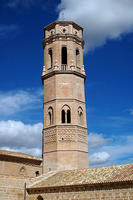You are in: Europe -> Spain -> Mudejar Architecture... , and traditional search or Image Gallery will yield results of this site only
Mudejar Architecture of Aragon
| Site number: | 378 |
|
| Type of site: | Cultural | |
| Date: | 12th century | |
| Date of Inscription: | 1986, 2001 | |
| Location: | Europe, Spain, Provinces of Teruel and Zaragoza, Autonomous Community of Aragon | |
Up to 75 images are shown here. Click on each for more details or on Image Gallery for more images.
| Description: | Mudéjar art in Aragon developed in the 12th century as a result of the particular political, social and cultural circumstances that abounded in Spain after the Reconquista. This art, encouraged by Islamic tradition, also reveals a range of contemporary European styles, above all the Gothic. There until the early 17th century, it is distinguished by architecture boasting an exceptionally sophisticated and creative utilization of brick and glossy tiles, especially within the belfries. --WHMNet paraphrase from the description at WHC Site, where additional information is available. | |
| The Mudéjar Architecture of Aragon is a World Heritage Site in Spain. The site was originally called Mudéjar Architecture of Teruel. It consisted of four churches in Teruel inscribed on the World Heritage List in 1986: Cathedral of Santa María de Mediavilla, Churches of San Pedro, San Martín and of the Saviour. In the 1990s, the inhabitants of Zaragoza remarked that there were other, not less notable examples of the Mudejar style in Aragón, which had been excluded from the site. Consequently, in 2001, the site was renamed to its present title and expanded with six monuments in Zaragoza and its province: Santa María in Calatayud, Santa Tecla in Cervera de la Cañada, Santa María in Tobed, Palacio de la Aljafería, Church of San Pablo, and La Seo Cathedral in Zaragoza. --Wikipedia. Text is available under the Creative Commons Attribution-ShareAlike License. | ||
| Source: | http://whc.unesco.org/en/list/378 | |
| Reference: | 1. UNESCO World Heritage Center, Site Page. | |
















